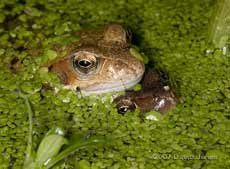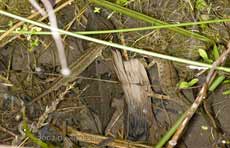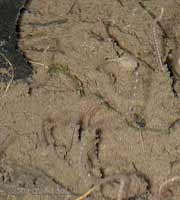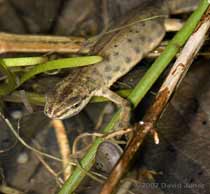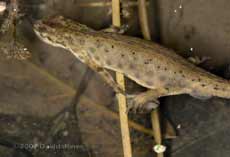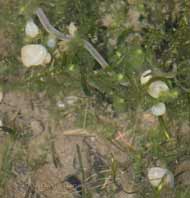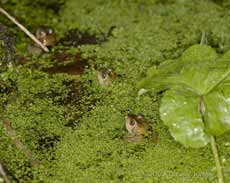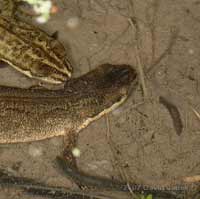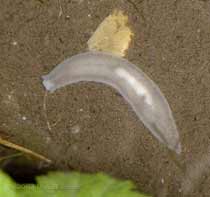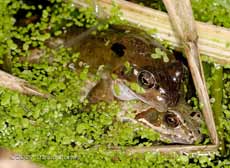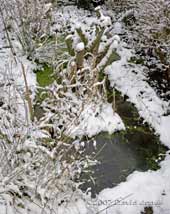Go to latest entry.1 January - 8 frogs visible at 9pm, with the water temperature 7C at 9pm (air temperature just below 5C after a day's high of 8.5C). 2 January - After a low of 4C last night and a high today of 8.5C, this evening the water temperature has dropped to 6C by 6.30pm, when I could see five frogs at the surface. 12 January - Like the rest of the garden, the pond has been almost completely neglected over the last week or so. I have still to complete clearing the shallow end before spawning gets under way, and unless we get very cold weather soon that may not be too long into the future. Tonight, with an air temperature of 11C at 8.15pm the water is up to 8C. Vegetation seems to be thriving, and there are even young leaves of Fringed Water Lily poking up through the Duckweed.
Last night I only counted six frogs, with I a pair together in the small pond - no sign of them today.
A quick look at the pond at 10pm had me dashing for the camera again, not this time for frogs, but for three Smooth Newts that were hunting in the shallow area cleared for frog spawning. The picture shows two that seemed especially interested in the same spot
I'm not sure what they were hunting for, but the high water temperature is certainly encouraging a lot of invertebrate life, the most obvious being the Water Louse (Asellus aquaticus), here in large numbers.
As I shone my torch onto the water it was also possible to see quite a few of these worms (Tubifex sp. ?) with their tails protruding from the muddy bottom and waving about in the water.
When the right-hand newt changed its position it was possible to see that it had fallen victim to one of the perils that await the newts in amongst the plants of the pond. It has a large Pea-shell Cockle attached to one of the digits of a front foot. I expect to see several newts caught like this during the year. Notice also the flatworm moving past to the left of the newt's head. It is moving across the underside of the water's surface film.
When the newt is moving slowly amongst the vegetation the attached cockle does seem to hinder it too much. However, when it launches itself out into the water to swim it can easily become an anchor that stops the newt in its tracks, as happened here when the cockle became caught behind a plant stalk.
The Pea-shell Cockles thrive in the pond and in the present mild conditions the young ones are obviously thriving and I could see quite a few of them. In this photograph you can see that the two in the lower-right of the image have a foot (or siphon) extended. An unidentified worm is feeding amongst the strands of weed that the cockles are attached to.
13 January - No pictures tonight as it is damp outside, but a check of the ponds at 9pm turned up 16 frogs and three newts (again), including the unfortunate newt photographed last night, still with cockle attached! Earlier in the day I completed clearing the shallow end of the big pond and it is now ready for spawning. 14 January - Today has been the brightest day since Christmas, and colder than recently, with a high of 9C after it dropped through the night to a low of 4C this morning at 8am. Tonight at 9.30pm it is already down to 4C again and is likely to drop more under partly clear skies. Not surprisingly, in the big pond the water has cooled and is now 6C. The frog count is down to six, and I can see no sign of the newts in the shallow area.
15 January - Nine frogs insight tonight, and a single newt was seen. It wasn't quite as cold today and as a result the pond thermometer was registering 7C at 10pm. Interestingly, the numerous young cockles that I could see in the shallow area of the big pond a couple of days ago have now all but disappeared - did they retreat under the mud as the water temperature dropped?
16 January - The unusually mild conditions continue (the mildest start to a year for over a century). Last night the temperature went up(!) to 10C and stayed there until this evening when it 'dipped' to 9C before starting to creep up again. Inevitably, the pond temperature has gone up - at 9.30pm the water in the big pond was at 9C.
The frog count is up to 18 tonight (at 10pm), with several large, mature individuals in evidence now.
At the shallow end, the warmer water has again brought out the cockles, and you may just make out a couple of small ones at the bottom of the next picture (or at least the large version of it). I counted four newts tonight, and this pair were certainly taking an interest in each other - at one stage the one nearest the camera positioned itself in front of the other newts and waved its tail vigorously in the way I would expect prior to mating, although there is no sign of a male's breeding season colours yet. The upper newt in the picture seems to have lost its cockle passenger, although I can't make out if it has also lost a digit! Also in the picture are numerous black flatworms.
In the top-right portion of this cropped image you can see the red and white banded tail of one of those worms protruding from a tube. There is another, larger segmented worm on the mud surface. Several times I noticed a newt dart down at the mud - were they catching worms?
17 January - Tonight I've taken a few closer and clearer pictures of the Tubifex worms that show more detail.
Just right of centre you can see what appears to be a different species of annelid (segmented, round) worm that is protruding out of a hole in the mud, rather than from a tube. Like the Tubifex worms it too was waving about in the water - I assume that, as with the Tubifex worms, it is the tail that we can see.
While I have seem quite a few of the small dark-coloured flatworms over this last week, this is the first example that I have seen this month of this almost white, much larger species called Dendrocoelum lacteum. This individual measured in excess of 15mm, whereas the smaller, dark flatworms are usually no more that 10mm long.
And finally, the first confirmed sighting of frogs in amplexus - I'm afraid it's a rather 'messy' photograph. The start of rain meant that I had to withdraw to the house before doing a head count tonight.
18 January - At the end of a stormy day I could see 19 frogs at around 11pm. While the storm had no detrimental effect on the pond, it has caused the duckweed to 'invade' the shallow end making it difficult to see any newts.
19 January - The frog count tonight at 6.30pm was 21 (with one pair in amplexus), and I saw 4 newts.
This morning, with snow on the ground, there was a thin film of ice on the ponds. Unfortunately, the electronic thermometer that monitors the water temperature has failed - I hope to sort that out tomorrow.
29 January - Although that snow disappeared quickly (as well as a bit more the next day), the pond remained just about ice-bound for two days, but since then the temperature has been rising again (pond thermometer still not working!). Despite the improving conditions, the frogs have been slow to resume their activities. Tonight I can see just six frogs in the big pond, and there are two newts active in the shallow end. The lack of rain has resulted in the water level dropping rather a lot, and with no rain forecast until at least the end of the week, I may need to top up the pond tomorrow. Click on images to see larger versions |
|
